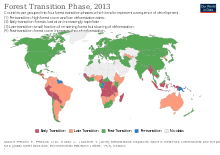

Forest transition refers to a geographic theory describing a reversal or turnaround in land-use trends for a given territory from a period of net forest area loss (i.e., deforestation) to a period of net forest area gain.[1][2][3][4][5][6][7] The term "landscape turnaround" has also been used to represent a more general recovery of natural areas that is independent of biome type.[2][8]
Changes in forest area (like deforestation) may follow a pattern suggested by the forest transition (FT) theory,[9] whereby at early stages in its development a country is characterized by high forest cover and low deforestation rates (HFLD countries).[10]
Then deforestation rates accelerate (HFHD, high forest cover – high deforestation rate), and forest cover is reduced (LFHD, low forest cover – high deforestation rate), before the deforestation rate slows (LFLD, low forest cover – low deforestation rate), after which forest cover stabilizes and eventually starts recovering. FT is not a "law of nature", and the pattern is influenced by national context (for example, human population density, stage of development, structure of the economy), global economic forces, and government policies. A country may reach very low levels of forest cover before it stabilizes, or it might through good policies be able to "bridge" the forest transition.[citation needed]
- ^ Mather, Alexander S. (1992). "The forest transition". Area. 24 (4): 367–379.
- ^ a b Walker, R. (1993). "Deforestation and Economic Development". Canadian Journal of Regional Science. 16 (3): 481–497.
- ^ Grainger, Alan (1995). "The forest transition: an alternative approach". Area. 27 (3): 242–251.
- ^ Mather, Alexander S.; Needle, C.L. (1998). "The forest transition: a theoretical basis". Area. 30 (2): 117–124. Bibcode:1998Area...30..117M. doi:10.1111/j.1475-4762.1998.tb00055.x.
- ^ Rudel, Thomas K. (1998). "Is there a forest transition? Deforestation, reforestation, and development". Rural Sociology. 63 (4): 533–552. doi:10.1111/j.1549-0831.1998.tb00691.x.
- ^ Perz, Stephen G. (2007). "Grand theory and context-specificity in the study of forest dynamics: forest transition theory and other directions". Professional Geographer. 59 (1): 105–114. Bibcode:2007ProfG..59..105P. doi:10.1111/j.1467-9272.2007.00594.x. S2CID 140182729.
- ^ Meyfroidt & Lambin 2011, p. 344.
- ^ Walker, R. (2011). "The scale of forest transition: Amazonia and the Atlantic forests of Brazil". Applied Geography. 32 (1): 12–20.
- ^ Meyfroidt & Lambin 2011.
- ^ Rudel, T.K. (2005) Tropical Forests: Regional Paths of Destruction and Regeneration in the Late 20th Century. Columbia University Press ISBN 0-231-13195-X